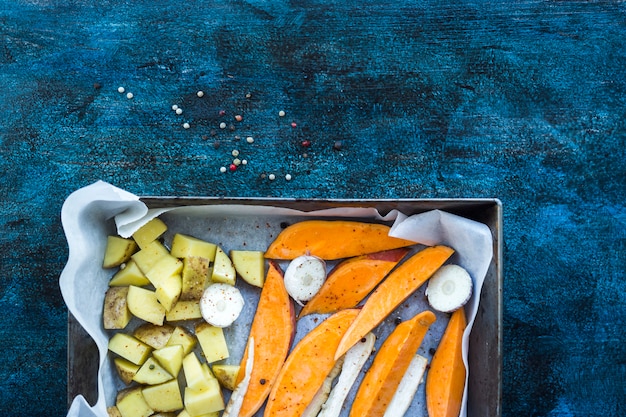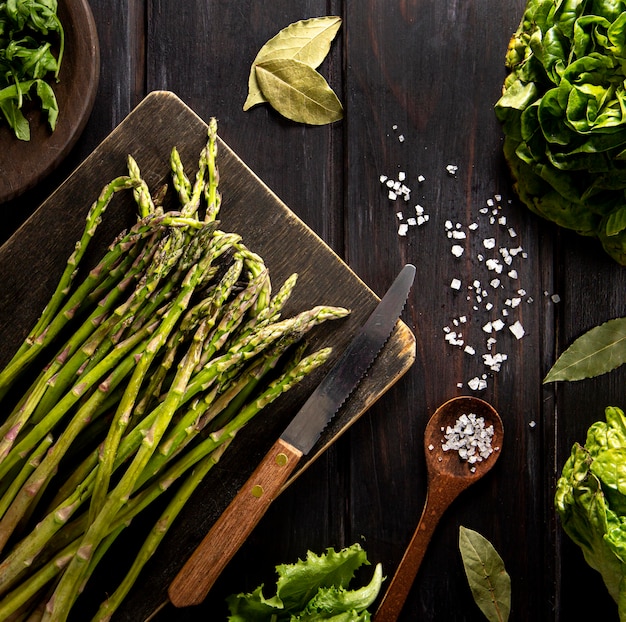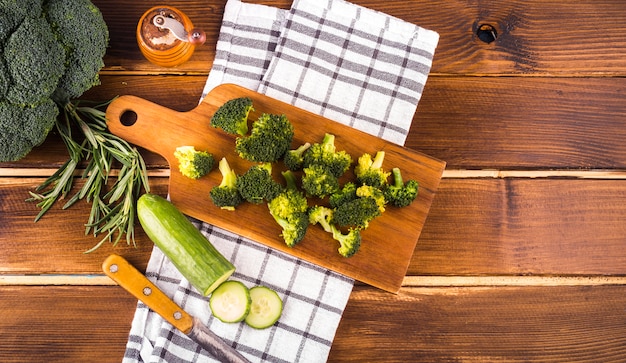Asparagus – that vibrant green spear, a harbinger of spring, a symbol of fresh beginnings. It's a vegetable that evokes a sense of anticipation, a promise of deliciousness. But let's face it, cooking asparagus can be a bit of a dance. Get it wrong, and you're left with a limp, watery mess. But get it right, and you'll be rewarded with a symphony of flavours and textures that will have you reaching for seconds (and thirds!). Today, I'm sharing my ultimate guide to perfectly roasted asparagus, taking you from selecting the perfect spears to serving up a culinary masterpiece.
(Part 1) Selecting the Right Asparagus: The Foundation of Flavor

It all starts with the asparagus itself. Think of it as building a house – you need the right foundation to ensure a sturdy structure. In the world of asparagus, that foundation is quality. A good selection of asparagus is the key to achieving that perfect roasted bite.
A Visual Guide to Freshness: What to Look For
First things first, look for those vibrant green spears. Think of a vibrant green, like a lush meadow, that's the colour you want. A dull, faded green is a sign that the asparagus has been sitting around a bit too long. Next, feel the spears. They should be firm and springy, not limp or floppy. Imagine a springy, fresh bed of asparagus - that’s the texture you want. Now, take a look at the tips. They should be tightly closed and pointy, not open and floppy. This is a sign of youth and tenderness, a guarantee of that melt-in-your-mouth texture.
The Power of Thick Stalk: The Key to Even Cooking
Now, let's talk size. For roasting, thicker asparagus is usually the best bet. Those thinner spears tend to get a bit dry when roasted. Think of a thick asparagus spear like a sturdy tree trunk, able to withstand the heat of the oven and maintain its texture. However, there's nothing wrong with using thinner ones – just be sure to watch them carefully and adjust the cooking time accordingly. Personally, I like a mix of sizes, like a forest with tall trees and delicate saplings, it adds a bit of variety to the dish.
Asking for Help: Unlocking the Secrets of Asparagus
If you're unsure about what to choose, don't be shy to ask the greengrocer or market vendor. They're like seasoned veterans in the asparagus world, full of tips and tricks. I remember once, I was hesitant about buying a bunch of asparagus, worried it might be a bit too old. The greengrocer, a jolly fellow with a twinkle in his eye, gave me a gentle pat on the shoulder and said, "Trust me, my dear, these spears are young and full of flavour." And he was right! He even showed me how to test the freshness by snapping the ends of a few spears. That's how I learned about the secret life of asparagus, a life full of flavour and texture.
(Part 2) The Art of preparing asparagus: A Culinary Choreography

You've got your asparagus – now it's time for the preparation, the essential steps that set the stage for a perfect roast. Think of it as a culinary choreography, a series of movements that lead to a beautifully prepared dish.
The Ritual of Washing: A Clean Start to Deliciousness
First things first, wash those asparagus spears thoroughly. Dirt and grit can hide in those nooks and crannies, so a good rinse is essential. I usually give them a good wash under cold running water, gently rubbing them with my hands to remove any debris. Imagine a gentle dance, cleansing the asparagus, preparing it for its transformation. No one wants a mouthful of dirt, do they?
Trimming the Tough Ends: A Subtle Balance of Flavors
Next comes the trimming. This is a bit of a debate among asparagus aficionados. Some people swear by trimming off the tough ends completely, while others trim only the woody, hard parts. My advice? It depends. If the asparagus is young and tender, you might not need to trim them at all. But if you find those tough, woody bits, trim them off, like pruning a rosebush to allow its beauty to flourish. It's all about achieving that perfect balance of flavour and texture. And remember, taste is subjective! Experiment and find what works best for you.
A Touch of Elegance: A Peel for a Refined Presentation
Finally, for a touch of elegance, you can peel the lower part of the stalks with a vegetable peeler. This removes any remaining tough fibres and gives the asparagus a more refined look. Think of it as putting on your best outfit for a special occasion, a touch of sophistication that adds to the overall culinary experience. It's not essential, but it can make a big difference in the final presentation.
(Part 3) Roasting to Perfection: A Culinary Transformation

We're getting to the heart of the matter now. The roasting process is where the magic happens, transforming those humble spears into a delicious, golden-brown side dish. It's like watching a caterpillar transform into a butterfly, a beautiful metamorphosis that unfolds in the oven.
Preheating: The Key to Even Cooking
First, preheat your oven to 400°F (200°C). This is crucial because it ensures that the asparagus cooks evenly, developing that lovely golden brown colour and achieving a tender texture throughout. Think of it as preparing the stage for a performance, setting the temperature just right for the asparagus to shine.
The Art of Tossing: A Dance of Flavors and Textures
Now, take those prepared asparagus spears and toss them with olive oil. The oil helps them get nice and crispy, and it also helps the seasoning stick. I use a generous amount of olive oil, but feel free to adjust to your taste. Think of it as a dance, swirling the asparagus in a pool of olive oil, preparing it for its transformation in the oven. And don't forget to season with salt and pepper. A pinch of salt brings out the natural sweetness of the asparagus, while a sprinkle of pepper adds a touch of heat and complexity.
Baking Sheet Brilliance: A Stage for the Asparagus
Next, spread those seasoned asparagus spears in a single layer on a baking sheet. Make sure they're not crowded, so they can roast evenly. Think of the baking sheet as a stage, giving each asparagus spear its own spotlight to shine. And then, pop that baking sheet into the preheated oven. You'll know they're ready when they're tender and slightly browned, typically around 10-15 minutes. But remember, every oven is different, so keep an eye on your asparagus and adjust the cooking time as needed.
(Part 4) Enhancing Flavors and Textures: A Symphony of Taste
We've got the basics down, but now it's time to take those roasted asparagus spears to the next level, to create a symphony of flavours and textures. Think of it as adding different instruments to an orchestra, each adding its own unique dimension to the overall sound.
A Squeeze of Lemon: A Bright and Tangy Accent
A squeeze of lemon juice is a classic for a reason. It adds a bright and tangy flavour that balances out the sweetness of the asparagus. Think of the lemon as a high note, adding a touch of brilliance to the dish. And if you’re feeling adventurous, try adding some lemon zest as well. It adds a beautiful aroma and a bit more zing, like a beautiful melody that adds depth and complexity to the overall flavour profile.
Garlic's Subtle Charm: A Depth of Flavor
A touch of garlic can really elevate the flavour profile. Roast some garlic cloves alongside the asparagus for a subtle garlic flavour, a soft undertone that adds depth and warmth. Or, for a more intense garlic flavour, try adding a tablespoon of minced garlic to the olive oil mixture before roasting. Imagine the garlic as a bass line, providing a solid foundation for the other flavours to shine.
The Crunch Factor: Adding Texture and Depth
For an extra layer of texture, try adding toasted slivered almonds or chopped walnuts. They add a nutty flavour and a delightful crunch, like a percussion section adding rhythm and energy to the symphony. Or, for a bit of spice, sprinkle with toasted sesame seeds.
(Part 5) Serving Suggestions: A Culinary Showcase
Your roasted asparagus is now ready to shine! But how do you serve this culinary masterpiece? Let's explore a few options, different ways to present this beautiful dish, like showcasing a work of art in different settings.
Simple and Delicious: A Classic Presentation
A simple serving is often the most satisfying. Pile those roasted asparagus spears on a plate and serve alongside your favourite dish. They’re perfect with grilled chicken, salmon, or roasted vegetables. Think of it as a simple yet elegant display, letting the asparagus speak for itself. You can even serve them alongside a hearty salad for a complete meal, a harmonious combination of flavours and textures.
Get Creative: Beyond the Conventional
But if you're feeling adventurous, there are endless possibilities. Try adding your roasted asparagus to a salad for a burst of flavour and texture, a touch of elegance that adds a new dimension to a classic salad. Or, add them to a pasta dish for a touch of sophistication, a delicate yet powerful addition to a hearty pasta dish. You can even use them to top a pizza for a unique twist on a classic, a vibrant and flavourful topping that elevates a humble pizza.
A Side Dish with a Twist: A culinary adventure
For a simple side dish with a twist, try adding some toasted bread crumbs to the asparagus in the last few minutes of cooking. The bread crumbs will soak up the juices and create a crunchy topping, like a sprinkle of golden confetti adding texture and flavour. Serve with a drizzle of balsamic glaze for an extra touch of flavour, a final touch of sweetness and acidity that brings the dish to life.
(Part 6) The Importance of Storage: Preserving the Flavors of Spring
We've covered roasting, flavouring, and serving, but what about the aftermath? How do we store those delicious asparagus spears so we can enjoy them later? Let's talk storage, preserving the flavors of spring so you can enjoy them long after the season has passed.
Storing for Freshness: A Short-Term Solution
If you need to store asparagus, it’s important to keep it fresh. Wrap it in a damp paper towel and store it in the refrigerator. The paper towel will help to absorb any excess moisture and prevent the asparagus from wilting, like a cozy blanket keeping it warm and protected. Ideally, you should use it within a day or two for the best flavour and texture.
Freezing for Future Use: A Long-Term Preservation
For longer storage, you can freeze asparagus. Blanch it first by dipping it in boiling water for a few minutes, then plunge it into ice water. This stops the cooking process and preserves the colour and texture, like capturing a moment in time. After blanching, drain the asparagus and pat it dry. Then, package it in freezer-safe bags and store it in the freezer for up to 6 months. Just remember to thaw it completely before using it in your recipes.
(Part 7) Asparagus: A Culinary Treasure: A Journey Through Time
You see, asparagus isn't just a simple vegetable. It’s a culinary treasure with a history dating back centuries, a timeless classic that has stood the test of time. It’s adaptable, versatile, and oh-so-delicious, a testament to the enduring power of flavours and textures.
A Brief History: From Ancient Romans to Modern Tables
The history of asparagus dates back to ancient times. It’s believed to have originated in the Mediterranean region, and was prized by the Romans and Greeks for its medicinal properties as well as its flavour. In fact, asparagus was so highly regarded in ancient Rome that it was even served at banquets for emperors. Think of it as a dish fit for royalty, a testament to its culinary excellence.
More Than Just a Side Dish: A Versatile Culinary Star
But asparagus isn’t just a side dish. It can be used in a variety of dishes, from salads and soups to pasta and risottos, a versatile ingredient that adds depth and complexity to a wide range of dishes. And don't forget about asparagus soup – it's a creamy, comforting delight that's perfect for a chilly evening, a warm embrace in a bowl.
A Symbol of Spring: A Taste of Fresh Beginnings
For many people, asparagus is a symbol of spring. It’s a welcome sight after the long winter months, and it marks the beginning of the fresh, vibrant flavours of the season, a reminder of new beginnings and the promise of warmer days. That’s why I always look forward to the arrival of asparagus in the markets every spring. It’s a sign that warmer days are just around the corner, a taste of the future.
(Part 8) Asparagus: A nutritional powerhouse: A Feast for the Body
Beyond its deliciousness, asparagus is also a nutritional powerhouse, a feast for the body, packed with vitamins, minerals, and antioxidants that contribute to a healthy and vibrant lifestyle. Let’s delve into the nutritional benefits of this wonder vegetable.
Rich in Vitamin K: Supporting Bone Health
Asparagus is an excellent source of Vitamin K, which is essential for blood clotting and bone health. Just one serving provides a significant amount of this important vitamin, a natural boost for strong bones and healthy blood.
Packed with Folate: Essential for Cell Growth
Asparagus is also a good source of folate, a B vitamin that plays a vital role in cell growth and development, essential for maintaining a healthy body. Folate is particularly important for pregnant women, as it helps to prevent neural tube defects in babies, a crucial element for healthy fetal development.
A Good Source of Fiber: A Boost for Digestion
Asparagus is a good source of dietary fiber, which is essential for digestion and overall gut health. Fiber helps to regulate bowel movements, lower cholesterol levels, and prevent constipation, a natural aid for a healthy digestive system.
Antioxidant Power: Protecting Your Cells
Asparagus is also rich in antioxidants, which help to protect your cells from damage caused by free radicals, helping your body fight off the effects of aging and disease. Antioxidants play an important role in preventing chronic diseases such as heart disease and cancer, a natural shield for your health.
(Part 9) Asparagus: A Culinary Adventure Awaits: Embrace the Possibilities
So there you have it – a comprehensive guide to perfectly roasted asparagus. From selecting the right spears to enhancing the flavours and textures, I’ve shared all my tips and tricks for creating a side dish that will impress even the most discerning palate.
Embrace the Experiment: A Journey of Flavors
Don't be afraid to experiment with different flavour combinations and serving suggestions. Asparagus is a versatile vegetable that can be adapted to suit your tastes and preferences. And remember, the beauty of cooking is in the journey, not just the destination. Enjoy the process of discovering new flavours and techniques, exploring the endless possibilities of this versatile vegetable.
A Culinary Adventure: The Joy of Cooking
As you delve deeper into the world of asparagus, you'll discover that it's not just a vegetable – it’s a culinary adventure waiting to be explored. So, grab a bunch of asparagus, put on your apron, and let's embark on a delicious journey together!
FAQs
| Question | Answer |
|---|---|
| How long should I roast asparagus for? | roasting time depends on the thickness of your asparagus spears. Thinner spears may only need 10 minutes, while thicker spears might take up to 15 minutes. Keep an eye on the asparagus and adjust the cooking time as needed. You'll know it's ready when it's tender and slightly browned. |
| Can I roast asparagus with other vegetables? | Absolutely! Asparagus pairs well with a variety of vegetables, such as cherry tomatoes, bell peppers, and zucchini. Just be sure to chop the other vegetables into similar sizes so they cook evenly. |
| What can I do with leftover roasted asparagus? | Leftover roasted asparagus can be used in a variety of ways. Add it to a salad for a burst of flavor and texture. You can also use it to top a pizza or to create a delicious asparagus frittata. |
| Can I freeze roasted asparagus? | It's not recommended to freeze roasted asparagus, as it can become mushy and lose its texture. However, you can freeze raw asparagus for later use. |
| What are some other ways to cook asparagus? | Asparagus can be cooked in a variety of ways, including grilling, sautéing, and steaming. Experiment with different cooking methods to find your favorite way to prepare this delicious vegetable. |
Everyone is watching

Prime Rib Roast Cooking Time Chart: Per Pound Guide
Cooking TipsPrime rib roast. Just the name conjures images of lavish dinners, crackling fires, and hearty laughter. It’s ...

How Long to Bake Potatoes in the Oven (Perfect Every Time)
Cooking TipsBaked potatoes are a staple in my kitchen. They're incredibly versatile, delicious, and surprisingly easy to m...

Perfect Rice Every Time: The Ultimate Guide to Cooking Rice
Cooking TipsAs a self-proclaimed foodie, I've always been a bit obsessed with rice. It's the foundation of countless cuisi...

The Ultimate Guide to Cooking Asparagus: Tips, Techniques, and Recipes
Cooking TipsAsparagus. The mere mention of this spring delicacy conjures up images of vibrant green spears, crisp and burs...

Ultimate Guide to Cooking the Perfect Thanksgiving Turkey
Cooking TipsThanksgiving. Just the word conjures up images of overflowing tables laden with delicious food, the scent of r...
